To evaluate the levels of the serum gamma globulin fraction in proteinograms as a biomarker to assess the severity, and to predict the mortality and new exacerbations in patients admitted for an exacerbation of a COPD.
Patients and methodsThe VIRAE study was carried out on a cohort of patients hospitalized for an exacerbation of probable infectious origin of COPD over a period of 2 years. The levels of the serum gamma globulin fraction were analysed in the proteinogram of 120 patients. The main clinical indicators of severity were also evaluated. Key features were compared in 2 groups (gamma fraction in the proteinogram greater or less than 6.6g/dl).
ResultsThe levels of the serum gamma fraction in the proteinogram correlated with the FEV1 (p=0.009), the CRP (p=0.04), and the number of readmissions after 6 months of hospitalization (p=0.04). We observed a good association with the GOLD scale, the BODE index and the mMRC dyspnoea scale; and also with treatment with oral corticoids and home oxygen therapy. We did not find it to be a good predictor of mortality, despite observing increased mortality rates one year after hospital admission in patients with low levels of the factor.
ConclusionsThe levels of the gamma globulin fraction in proteinograms have a good correlation with the FEV1. In addition, they are associated with a greater severity of patients with COPD. This simple biomarker may be useful in identifying high-risk patients.
Se pretende evaluar los niveles de la fracción de gammaglobulinas en suero como un marcador biológico para valorar la gravedad y predecir la mortalidad y nuevas agudizaciones en los pacientes ingresados por una agudización de la EPOC.
Pacientes y métodosEl estudio VIRAE es una cohorte de pacientes ingresados por una agudización de probable causa infecciosa de la EPOC en un período de 2 años. Se analizaron los niveles de la fracción de gammaglobulinas del proteinograma en 120 pacientes. Se evaluaron los principales indicadores clínicos de gravedad. Se compararon las características principales en 2 grupos (mayor o menor de 6,6g/dl de la fracción gamma del proteinograma).
ResultadosLos niveles de la fracción gamma del proteinograma se correlacionan con el valor del FEV1 (p=0,009), la PCR (p=0,04) y el número de reingresos a los 6 meses de la hospitalización (p=0,04). Se demuestra una buena asociación con la escala GOLD, el índice BODE y la escala de disnea de mMRC; y también con el tratamiento con corticoides orales y la oxigenoterapia domiciliaria. No hemos observado que sea un buen predictor de mortalidad, aun observando una mayor mortalidad al año del ingreso hospitalario en los pacientes con niveles bajos.
ConclusionesLos niveles de la fracción de gammaglobulinas en el proteinograma tienen una buena correlación con el FEV1. Además, se asocian a una mayor gravedad de los pacientes con EPOC. Este biomarcador sencillo puede ser útil para identificar pacientes de alto riesgo.













